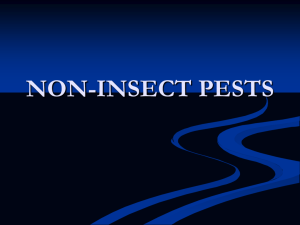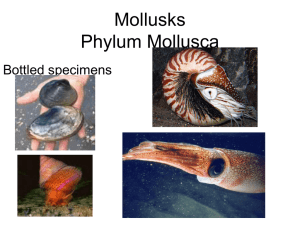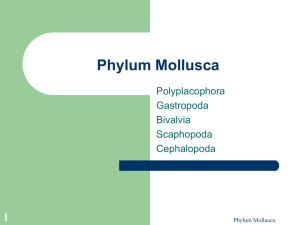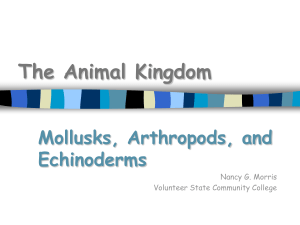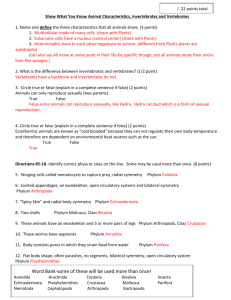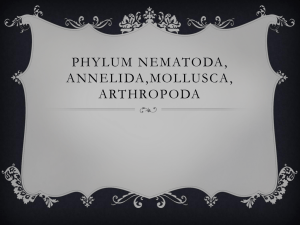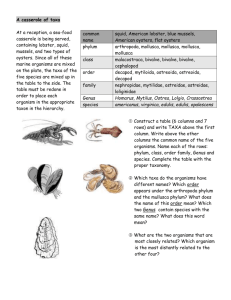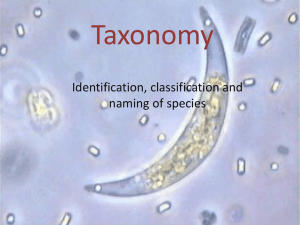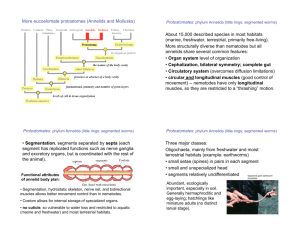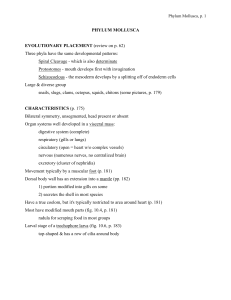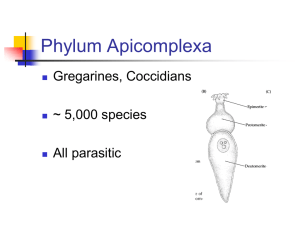bio202_lab10
advertisement
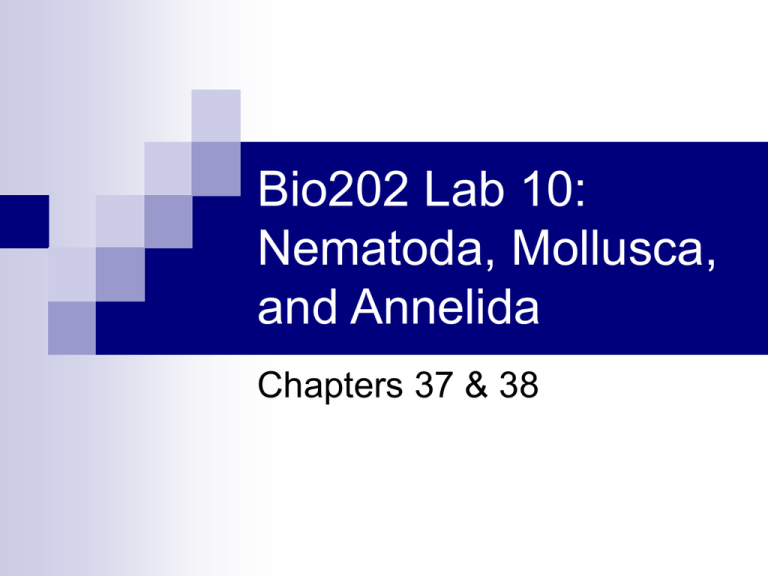
Bio202 Lab 10: Nematoda, Mollusca, and Annelida Chapters 37 & 38 Phylum Nematoda Nematodes, commonly called roundworms Ubiquitous--found everywhere, span all habitable environments bilaterally symmetrical Cylindrical Unsegmented (unlike most tapeworms) Phylum Nematoda Pseudocoelomate – body cavity between mesoderm and endoderm Contrast with Acoelomate, Coelomate (Fig 38.1) advanced animal characteristics complete digestive tract and other internal body cavities Most species of nematodes are free living, though the most infamous species cause disease. Phylum Mollusca Mollusks are far more diverse than most people realize. Snails, Clams, Octopuses, Squid, Chitons Occur in marine, freshwater, and terrestrial habitats. Bilaterally symmetrical Coelomate – body cavity bounded by mesoderm Contrast with Acoelomate, Pseudocoelomate (Fig 38.1) Phylum Mollusca Protostomes Bilateral Metazoan Determinate, spiral cleavage Cleavage Spiral Cleavage In Mollusk Embryo Spiral Cleavage In Mollusk Embryo Phylum Mollusca Protostomes formation of a mouth and anus directly from a blastopore (opening in blastula) formation of the coelom by splitting of the embryonic mesoderm Blastula and blastospores Solid ball of cells (morula) develops fluid-filled center (blastocoel). Blastospores are produced by budding of blastula Phylum Mollusca Mollusks are far more diverse than most people realize. Snails, Clams, Octopuses, Squid, Chitons Bilaterally symmetrical Protostome Coelomate Occur in marine, freshwater, and terrestrial habitats. Phylum Mollusca Visceral mass – tissue forming center of body muscular foot used in locomotion many mollusks have a head most mollusks form a shell, and are classified by shell type Radula organ used for scraping, drilling, or capturing prey. Not found in Bivalves Phylum Mollusca circulatory system Heart usually, an open system through which the blood circulates freely. Class Polyplacophora (chitons) Shell eight dorsal overlapping plates Foot ovaly flattened extends from back to front (dorsoventral) Mouth scraping Chiton sp. radula. Class Gastropoda (snails) Gastropods are terrestrial as well as aquatic. shell single and often coiled, sometimes absent. Mouth has a radula. Class Bivalvia (clams, oysters) Shell Foot flattened on the sides (laterally) often used to burrow Mouth in two dorsally hinged halves (valves). no radula. Cilliated gills used for filter feeding can filter particles as small as a virus; oyster harvesting is quickly shut down following a pollution alert. Anodonta sp. Pinctada sp. Class Cephalopoda (octopus, squid) Shell Usually absent single and coiled if present (very rarely). Foot modified into tentacles image-forming eyes mouth usually with pinching beak. Loligo sp. Phylum Annelida (Segmented Worms) Segmented segments are divided internally by septa bilaterally symmetrical Protostome coelomates. Cerebral ganglion (brain) is well developed circulatory system is closed digestive tract is complete. Class Polychaeta (marine worms) Body is distinctly segmented (believed to be an adaptation to burrowing). Segmentation allows fine control of annelids’ hydrostatic skeleton in concert with circular and longitudinal muscles to alternately expand and contract segments to aid burrowing. Class Polychaeta (marine worms) paired appendages of each body segment are apparent in polychaetes. This arrangement of appendages indicates a common ancestry with arthropods (next chapter) Leeches are the most modern and highly modified of the annelids, as is true for parasitic groups of other phyla. Why is that a common theme? Class Polychaeta (marine worms) body is distinctly segmentedThe most anterior (toward the rear) segment (prostomium) has sense organs as a head. Parapodia: paired, lateral appendages extending from the body segments Setae: small, bristlelike appendages often occuring in pairs on lateral and ventral (frontal) surfaces Nereis sp. Aphrodita sp. Chaetopterus sp. Class Oligochaeta (oligochaetes) Segmentation Distinct No parapodia Prostomium (38.12) Fleshy, small lobe before mouth. Setae present but small Lumbricus terrestris Class Hirudinea (leeches) Body Flattened anterior (frontal) and posterior suckers no head development. Segmentation greatly reduced No setae Hirudo medicinalis
